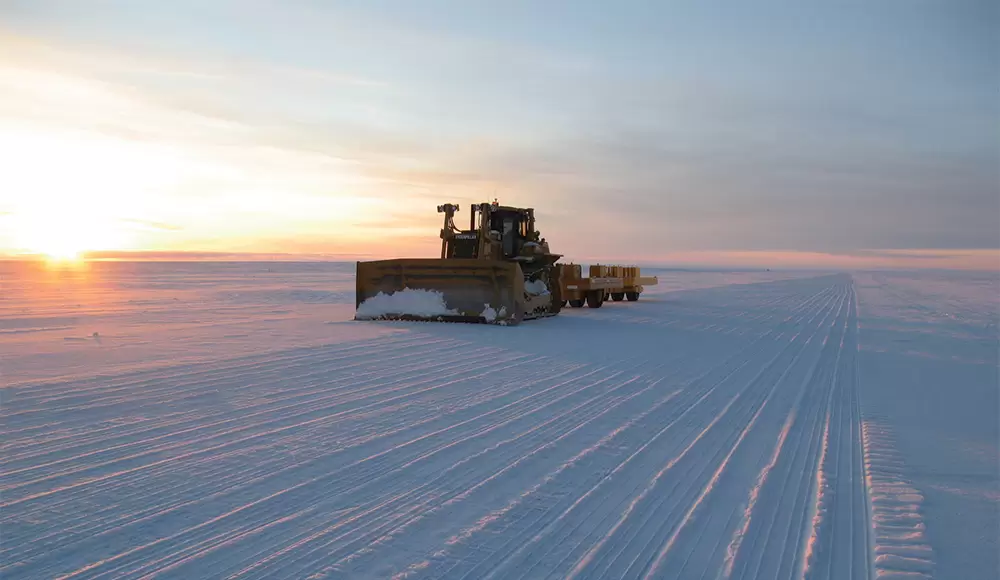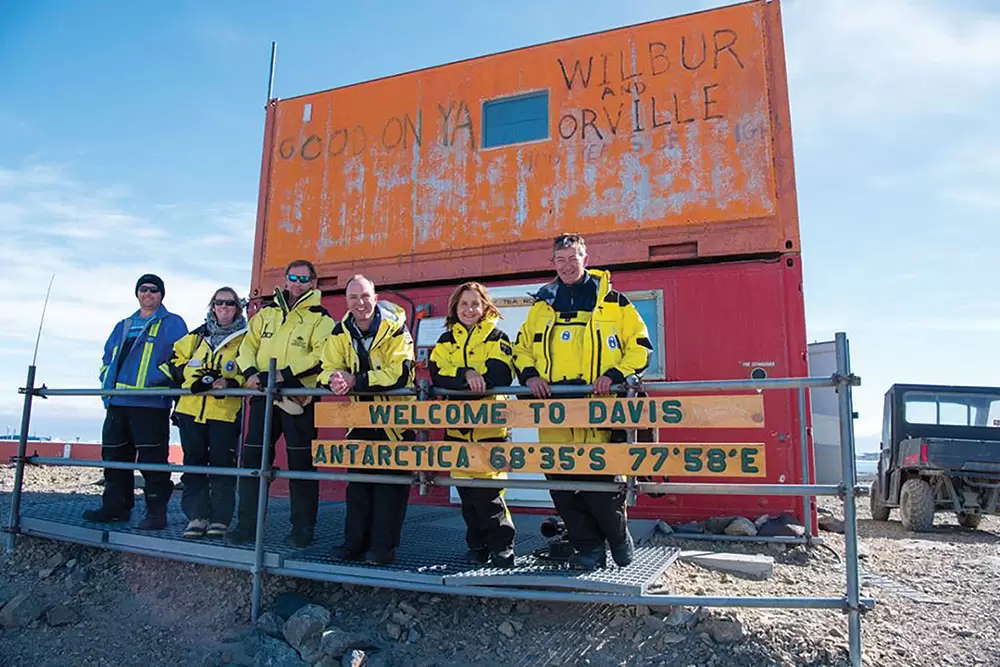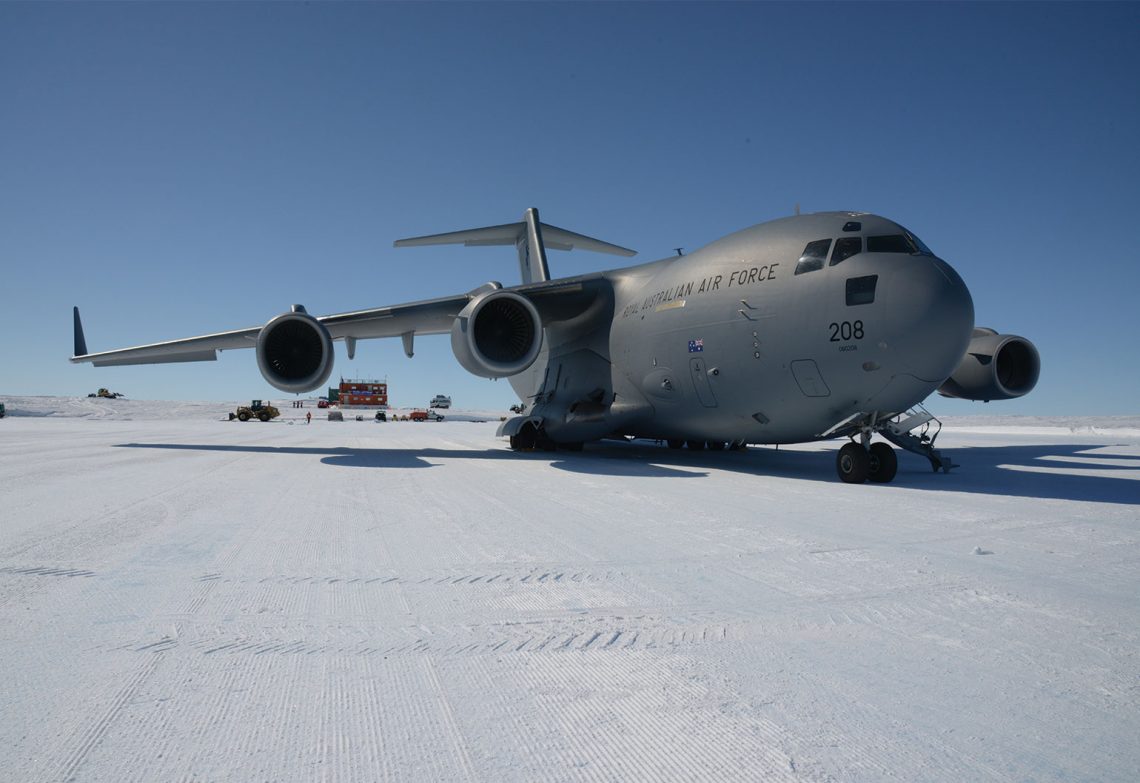Outside of the summer months, aeroplanes cannot land in Antarctica. With the Davis Aerodrome Project, the Australian Government proposes to change that.
Perhaps unsurprisingly, a decade spent looking after Australia’s infrastructure in Antarctica leads to many great adventures for an engineer.
For Engineers Australia Fellow Chris Paterson FIEAust, previously Chief Engineer of the Australian Antarctic Division (AAD), one of these was the search for a site for an all-weather runway.
“I had seven trips to Antarctica, and the last of those was a summer at Casey research station, where we were working on the current Wilkins Aerodrome,” said Paterson, who is now AECOM’s Group Director, Civil Infrastructure.
“During the time I was with AAD, we looked at sites for runways around Davis research station and explored the concept of a year-round airlink. When there are issues with a runway melting, or being too soft to land on, it requires an engineered solution.”
The current Wilkins Aerodrome, which is carved into glacial ice and commenced operations in 2007, only allows access during part of the summer season.

It generally opens in late October, then shuts down in late December for approximately six weeks due to higher ice temperatures. The airstrip then reopens in February and operates until March, when it closes again for the colder seasons.
It takes two months to get the runway up and running after winter before it can be used by wheeled aircraft. The site must be cleared of winter snow and the surface ice requires suitable bearing strength. Then it’s tilled by a snow groomer to create higher friction levels.
An increasing risk with ice runways such as Wilkins is the increasingly common periods of inoperability in the summer months, which could be linked to global warming.
“At Wilkins, we’ve only got very specific times in which we can operate,” said Engineers Australia member and Chartered engineer Stu Gibson MIEAust CPEng, Project Manager with the AAD’s Davis Aerodrome Project.
“What we need is reliable, year-round access to the continent. There is currently no facility in Antarctica that has this, and the benefits include greater efficiencies in improved scientific data collection, benefits for biological studies, improved safety and emergency response capabilities, enabling new models of international collaboration and enhanced logistics to support new and emerging technologies.”
The proposed solution, as suggested in Gibson’s job title, is the Davis Aerodrome Project.
It’s a gutsy plan for a bold piece of engineering, pending environmental assessments: a concrete airstrip 2.7 km in length and 45 m wide, located 4.5 km from Davis station.
The challenges of the build are mind-boggling.

First, there’s the fact that the construction site is approximately 4850 km away from Hobart.
The journey by icebreaker takes around 14 days, not including two weeks in biosecurity at the Hobart port before materials can even be loaded on to the ship.
Then, there’s the issue of accommodation, a key consideration in the logistics and operations of a feasible working site. Davis houses about 90 expeditioners each summer, but such a project would require an expanded station population of 250 people for engineering, construction and other specialists.
Finally, there’s the vexing issue of the last mile of delivery.
“Essentially, it’s a logistics challenge just as much as an engineering challenge,” Gibson said. “That is something that has contributed to the current engineering solution.”
A subzero runway
The AAD solution uses precast, pre-stressed concrete slabs, grouted together on the ground to form an airstrip. These are essentially pavers that are intended to have as light a touch as possible.
Then there’s the added challenge of permafrost, plus the several 4850 km journeys by icebreaker and ice-strengthened cargo vessels required every year during the construction phase, to transport the estimated 11,500 pavers, each weighing about 10 t.
And how are these pavers transported over the last mile?
“That ship-to-shore process is the really tricky piece,” Gibson said. “What we have to do is enhance our wharf logistics, with a facility that’s going to provide increased throughput of construction materials such as the slabs and all the machinery that are going to support the construction efforts.
“We are looking at several icebreaking cargo ships per season, making three to four trips per season, over multiple seasons, and suitable access and anchorage near Davis station.”
The site, in an area known as Vestfold Hills in East Antarctica, has been selected because it is ice-free and has a fairly consistent rock base.

Matt Filipowski/AAD
“Compared to some of the other sites investigated in the area, it’s less susceptible to permafrost,” said AAD’s Project Design and Engineering Lead, an Engineers Australia member and Chartered engineer Dr Tim Ramm MIEAust CPEng.
“There are a couple of sediment-filled valleys that the runway will traverse, but predominantly it would be on very high-strength bedrock.”
Earthworks for the runway construction would use site-won materials such as existing rock.
“The runway itself, though, and all of the plant, equipment and materials, must take the journey by sea,” Ramm said.
The other major issue is managing permafrost and frost action in soft-sediment areas.
“We don’t see permafrost very much in the Australian engineering field,” Gibson said. “But it can be a big issue in Antarctica because it causes a lot of instability.”
Year-round access
The Davis Aerodrome Project is a serious undertaking and will be a significant piece of engineering. But why go to so much effort and expense to create an ability to land in inhospitable Antarctic seasons?
“Think of the science opportunities enabled through enhanced logistics,” Gibson said.
“At the moment, we’re seeing science outcomes very much constrained because of a lack of reliable access to the continent during certain seasons. So, we’re talking about getting scientists in and out of the continent quickly, and repatriation of samples to be analysed, at any time.
“Over the past five or six decades, the vast majority of the science conducted in Antarctica has been between October and March. But the really important, scientifically vital times in other parts of the year are when the wildlife come in and out of the continent, for example.”
The project, which is to be completed by 2040, is committed to the highest levels of environmental stewardship, Gibson says. Its planning seeks the best balance between engineering and environment, but its outcome is about ensuring environmental protection through deeper knowledge of the ecosystem throughout the Antarctic year.
Antarctica has been accessible over the past 100 years by many countries, with aviation forming part of a long and established history. The size of Antarctica is larger than Australia, with the Davis aerodrome similar in size to a single airstrip.
There are already more than 20 “airstrips” on the continent — they’re just not available year-round. The aerodrome will enhance scientific activities, as well as logistical and emergency response capability, and future-proof the AAD for decades to come. The aerodrome will not be used for any form of tourism.
Paterson said a challenge facing researchers is that if an engineer or other specialist is required, they may not be able to come in until the next summer season.
“What we see from this enhanced capability in accessing the continent in areas that wouldn’t normally be visited is revolutionary new science,” Gibson said. “The possibilities that would be enabled through year-round access would further revolutionise the science that’s currently undertaken.”

Extreme conditions
Time spent on our planet’s southernmost continent is not for everybody, Paterson said.
“I do think it takes a particular type of engineer to work in Antarctica. There is a lot of first-principles engineering and a lot of solving the same problem differently, because of specific constraints. You need to be innovative: a person who looks for solutions and has a can-do attitude.
“There’s also a lot of planning. For example, at Davis station the normal resupply is at the start of summer. If you overlay the procurement-of-materials cycle with the hiring-of-people cycle and the short summer season, you might have to plan to do something in year one. In year two, you get the design done and the materials procured, delivered and sent south. Then the materials sit there for the winter until, in year three, people are brought in to do something with them.
“Everybody handles the challenges differently. When you’re there for the first time and the sun doesn’t set, you do lose track of time. In summer it might be minus-17 outside, so you have to spend a lot of time getting dressed to go outside and then, if you forget something, you have to spend a lot of time removing all of your gear, finding the item and getting dressed, again. So even the simple act of going outside to do something takes a good deal of planning. Antarctica is not a place for the impatient.”
Australian Antarctic Division roles are listed at https://jobs.antarctica.gov.au. Register your interest to be notified when annual expeditioner recruitment opens in December.




I looked at the design and construction concept of precast interlocking pavers for this Antarctic airstrip in October 2019. The pavers were nominally cruciform 1.25 tonne panels x 500 thick in high performance high strength concrete on an engineered compacted drainage subgrade with geogrids separating fine screened gravel from coarse screened rubble. Surface of panels had ribs for grip. Precast panels to be made and shipped from Albany on skids, which when unloaded could be easily dragged to location. A key concept was that the bulk of the plant in construction would be operate remotely from Perth, WA, with a just small crew to service the plant on the base. This permitted a longer effective construction period each year 24 hours per day. The panels could be readily lifted and replaced if damaged. It was an interesting challenge.
Why not construct the airstrip using aircraft landing mats as used in the Second World War in se Asia. They were Approx 3 m • 900 mm that locked together to form a steel meshed surface that was laid over soft cleared ground They used clips to lock together and placed by teams of 2 men. The idea could be increased in size for laying by machine
I am very disturbed by any plan to build a concrete runway in the Antarctic. The beauty of Antarctic Peninsula and Deception Island have already been impacted on by abandoned whaling infrastructure and dis-used research stations. Our focus should be on touching the surface very lightly and not leaving any permanent imprint – concrete is a terrible idea.
WE are working on a project at the NZ base and agree with the need for planning and patience. Our most recent project was designed and materials delivered at the end of 2019 with first plan to install Christmas 2020. With changes in planning we now will be waiting to Christmas 2022 as interim steps need to be completed in the 2021 work block. Being on vase over summer is amazing with permanent daylight. Our worst day in 2019 was -20 degrees as we were working outdoors.